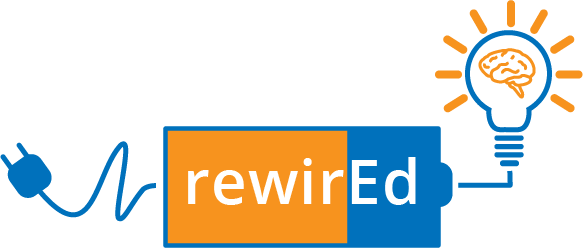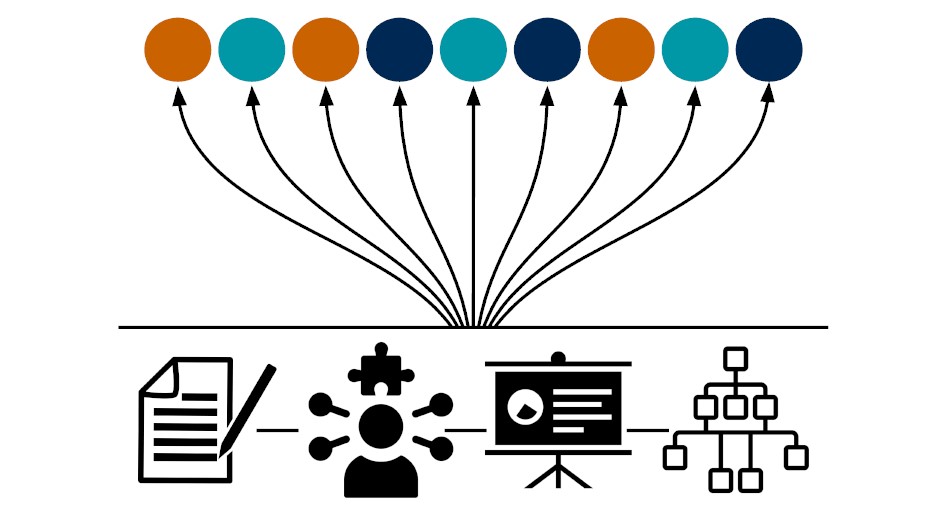In a recent interview, Thomas Williams asked me what my favorite instructional design model was for working in higher-ed. My answer:
“I don’t have a favorite. I kind of mix them depending on the project. And that mix always ends up looking like Design Thinking.”
Design Thinking takes six steps: Empathize, Define, Ideate, Prototype, Test, Iterate. But before I speak more on that, I’ll break down what I think about the Big 3 ID Models that employers ask about (even though they probably just googled “ID Models” when they were writing the job description). Those models are ADDIE, Dick & Carey, and SAM. I’ve created visuals of each model which include how they might be used in a higher-ed context.
A.D.D.I.E.
ADDIE (Analyze, Design, Develop, Implement, Evaluate) paints the parts of the design cycle with a very broad brush and is really more of a budgeting tool so freelancers can justify the ID process to clients. For example, “the Analysis phase is going to take this long and we’re going to do these things, and because of it’s importance to the project as a whole its worth this much of the budget”. But that’s a really rigid way of actually designing a project. So, it runs the risk of being a classic case of the map not being the terrain or the plan not surviving the battle field. So, I tend to not use this waterfall model unless I know the project is very simple. And even then I adjust and skip parts to suit the needs of the project. In higher-ed I’d be surprised if anyone uses ADDIE beyond breaking down the pieces of a project after the fact.
Here’s what it might look like from a Higher-Ed perspective:

Dick & Carey
Dick and Carey is a bit more realistic because the whole thing is based on backwards mapping and ensuring alignment. There’s also an iterative element to it. It’s still a waterfall, but it’s less of a waterfall. And I like it… because it fits well with the general Higher-Ed instructional design process. But it still needs to be a bit more flexible. This type of model tends to produce very precise learning experiences. Almost like Action Mapping for a specific behavior change. And that can be an issue with a nuanced group of college students as opposed to a group of professional who will all use a specific skill in a specific context. It’s like the difference between the bands Rush and Phish, one is all theory and no soul, the other is all soul and no theory. What you want is Radiohead, equal parts of both. So, I feel like Dick & Carey is great for skills training, but maybe not the best for knowledge and attitudes. It’s more on the Rush side of the analogy.
However, it’s strongly aligned with some very good learning theory, especially cognitive information processing and instructionalist theories like Gange’s Conditions and Events. As such, Dick & Carey does have a lot going for it in terms of creating effective training and ensuring alignment. It just might not be the best route to crafting the deeply meaningful learning experience expected from the higher education milieu. A similar, bigger-picture model would be Understanding by Design. I highly recommend checking that out if you design instruction for college courses. The crux of it is to begin with the end in mind. That’s great advice for any designer.
Here’s what Dick & Carey might look like from a Higher-Ed perspective:

SAM
The successive approximation model (SAM), which is Michael Allen’s way of rebranding Agile as more academic sounding, is an extremely helpful model. I really like this model because it reflects the nebulous reality of how design projects usually flow and then gives it some guidance and structure. It’s laid out in three general steps—Prep, Design, and Develop. It sets up your project to be rapidly prototyped in a series of sprints so you can make consistent adjustments based on pretty immediate feedback. It’s a great model. A great model. But, it’s not a cure-all. It’s invaluable for short dead lines and small projects. However, using SAM for a 14 week course on a 16 week design cycle might not be your best bet because of stakeholder schedules, last minute interventions, or the multi-faceted nature of a semester long learning experience. If there aren’t too many cooks in the kitchen, this model will work really well if adjusted for the Higher-Ed context. Though, depending on the project, some parts might have to be thrown out all together. So, I say, take it and make it your own.
Here’s what it might look like from a Higher-Ed perspective:

Design Thinking
When it comes to designing college courses, I find it best to synthesize the models to fit the characteristics of whatever project I’m working on. And that usually ends up looking like the Design Thinking model. You get the budgeting quality of ADDIE, the Pedagogical properties and alignment of Dick & Carey, and the flexibility, prototyping, and feedback provided by SAM. But, as most answers to ID related questions go… “it all depends on the project”. There is no one answer.

This is why I like Design Thinking so much. The stages are flexible and can be applied to both specifics and the bigger-picture. When it comes to identifying a need, crafting an objective, solving a problem, selecting a pedagogical intervention, or building the course in the LMS, it considers the perspectives of the learner as well as the instructor. But above all, it’s so flexible that we can take any piece from any other model and make it work for the Design Thinking framework.



